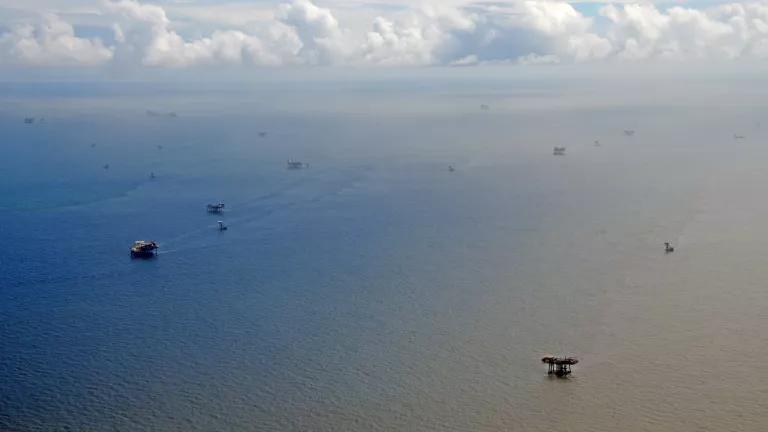In honor of New York Governor Cuomo’s State of the State tour, here’s a look back on some of last year’s key ocean successes and a glimpse of what’s needed in 2017.
Governor Cuomo’s leadership on ocean issues gave us much to be grateful for in 2016.
In 2016, the state:
- Established a state ocean acidification task force to tackle challenges facing New York’s shellfish and fisheries as a result of ocean chemistry changes. Acidic water makes it harder for many species of shell-building organisms like oysters and scallops to grow their protective coverings and survive. Ocean acidification could also be having an impact on important recreational fish like summer flounder (fluke) and other fish species as well.
- Participated in the development and release of the first-ever Mid-Atlantic Regional Ocean Action Plan, together with other coastal states, regional fisheries managers, federal agencies and tribes—and with significant stakeholder and public involvement. The Plan sets out best practices for agency collaboration on a host of burgeoning issues, from offshore sand mining to aquaculture, so that agencies work together more efficiently to advance responsible development.
- Took initial steps to develop a State of the Ocean Report through hosting a workshop to begin identifying ocean health indicators. A final report should lay out baseline conditions, indicator targets and actions, and timelines to achieve these conservation metrics; by watching these, we will be able to more clearly quantify our successes and pinpoint areas that need more attention.
- Enhanced our commercial fishery observer coverage to better scientifically quantify the amount of bycatch—fish, turtles, and marine mammals that are thrown back, often dead and dying. Having improved data on this issue will help us figure out together how best to fix it.
New York is also close to:
- Finalizing its New York Ocean Action Plan so that it can officially direct ocean management decisions.
- Announcing aerial and acoustic whale monitoring contracts that will yield data to help us develop better management measures to ensure these magnificent mammals safe passage through our waters amid busy shipping lanes and increased industrial uses. As big as whales are, they can’t match the power of massive ships often traveling at 15 mph or more. Collisions can shatter whales’ bones and slice through blubber and underwater noise makes it hard for whales and other marine life to communicate. Many types of whales are already endangered—losing even a few whales can translate into population impacts.
- Holding a workshop with scientists to design a sea turtle monitoring plan to protect these endangered and threatened species that frequent our waters and are vulnerable to fisheries interactions.
In order to ensure we do not lose ground on these achievements, adequate funding needs to be allocated towards research to make improved management decisions and dedicated staff to lead these projects. America’s Atlantic is busier than ever before and we must make smart decisions to ensure development can proceed in a way that conserves our abundant and rich variety of ocean life and the families and businesses that depend on a healthy ocean.
Last year, New York State invested a record $15 million toward ocean and Great Lakes protection as part of a historic expanded Environmental Protection Fund of $300 million. We hope to see the same commitment to sustain the state’s cutting-edge conservation work in 2017.
Funding should be used to ensure that, for example:
- The state ocean acidification task force has the staffing needed to meet its milestones, and creates and funds a baseline monitoring system that builds on existing ocean observations to begin monitoring ocean pH and carbonate. New York is one of the states most vulnerable to ocean acidification, due to our economic dependence on shellfish harvesting and because our waters have high levels of nitrogen pollution, which amplifies acidification.
- Our State of the Ocean Report is quickly developed and a regular process for monitoring and reporting is enacted. Our ocean is changing rapidly and we need better data to predict environmental changes and plan for any necessary adaptations.
- New York launches a shipboard survey monitoring program. Shipboard monitoring was a key piece of the whale monitoring plan designed for the state by leading whale experts, but when bids came in far above the state’s proposed budget, shipboard monitoring was cut. We should flesh out the whale monitoring work in the way the scientific community recommends, while adding this research component to existing and planned monitoring for sturgeon, turtles, and other species of concern.
- New York participates in regional efforts to identify and conserve wildlife and habitat spaces both throughout the region and here at home that keep our ocean resilient and drive other industries like fishing and recreation. Knowing where important ecological areas are will help managers and industries make better and quicker development decisions.
New York's ocean is an economic powerhouse for the state. In 2013, ocean sector industries, such as fishing and tourism, contributed more than $22 billion to New York's gross domestic product (GDP) and supported more than 328,000 jobs. But only a healthy ocean can continue to provide the jobs, food, and recreation we rely on and enjoy.
In 2017, we hope to see New York continue to safeguard our ocean and encourage smart, sustainable development of its resources—for the benefit of our state’s citizens, the region, and our nation.




